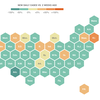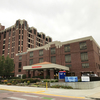
[ad_1]

Clark County Commission Vice Chairman Lawrence Weekly swabs his nose while giving a coronavirus test to himself during a tour of setup at a temporary coronavirus testing site in Las Vegas on Aug. 3.
John Locher/AP
hide caption
toggle caption
John Locher/AP

Clark County Commission Vice Chairman Lawrence Weekly swabs his nose while giving a coronavirus test to himself during a tour of setup at a temporary coronavirus testing site in Las Vegas on Aug. 3.
John Locher/AP
After a 90% drop in visitors during its lockdown, the Las Vegas area has spent the summer trying to regain its economic footing while battling a resurgence of the coronavirus that is straining the health care system.
Even with recent gains in slowing the spread, Nevada still has one of the highest rates of new infections relative to its population in the country, rivaling some of the hardest hit southern states. Its positivity rate — another key metric — shows more than 15% of tests are coming back positive.
Last week, Nevada’s Democratic Gov. Steve Sisolak warned the state was in a “precarious position” as it moved from a statewide “phased” approach to a more targeted, long-term mitigation plan.
An NPR analysis shows that the rapid growth in new cases relative to the number of hospital beds available in the Las Vegas area could signal a problem. The region’s hospitals are not near capacity yet, but some individual facilities have been getting close, according to the Nevada Hospital Association.
Mason VanHouweling, CEO of the large public hospital University Medical Center of Southern Nevada, said Las Vegas has surge plans in place to add more beds, if necessary.
“We have the convention center that can flex up to 900 beds. We’ve also engaged hotels and other facilities, but we just haven’t had to execute those plans fortunately,” VanHouweling said.
Nevada’s hospitalizations for COVID-19 are gradually decreasing, after rising sharply last month.
When casinos reopened on June 4, Nevada was averaging between 100 to 200 new coronavirus cases a day. By mid July, that number had shot up to more than 1,000.
Still, VanHouweling says he’s encouraged that hospitals have managed the influx of patients and doesn’t foresee that an increase in tourism will jeopardize the health care system or public health response.
“It’s a great time to come, there’s great bargains,” he said. “I just know from an infectious disease standpoint, they have done a great job in all of our resorts and casinos.”
In order to stay open, Nevada casinos are required to reduce capacity by 50% and to keep customers and staff socially distanced and wearing facemasks, among other things.
“There’s no chance, in my opinion, that a community like southern Florida or New York could possibly be as coordinated, integrated as Las Vegas,” said Jim Murren who chairs Nevada’s COVID-19 Response, Relief & Recovery Task Force and former CEO of MGM Resorts International.
“The fact that the resorts are open at the levels that they’re open, I think, is appropriate,” said Murren, who points out that state gaming regulators are closely monitoring casinos on their public health practices.
Murren said the task force has used the private sector to work in parallel with the state government on coronavirus, which has helped Nevada buy personal protective equipment at reduced prices and improve testing capacity and contact tracing.
“This has had a very meaningful impact on a state that is small relative to its neighboring states and under-resourced in some respects,” Murren said. “We’ve been able to punch way above our weight.”
In some ways, Las Vegas is more vulnerable than other metro areas to a surge of COVID-19 patients.
Nevada has long struggled with a shortage of health care workers, with fewer physicians and nurses than the national average.
Because it’s geographically isolated, that could also make it more challenging to transfer patients if hospitals were overtaxed, said Brian Labus, a professor of public health at the University of Nevada, Las Vegas.
“Vegas is essentially an island so that’s a huge challenge, if we need to think about transferring patients,” Labus said.
The region has also grown quickly and some sectors including health care have not kept pace with the populations’ needs, he said.
When it comes to controlling coronavirus, Las Vegas is also at the mercy of visitors who may not be inclined to follow public health guidance.
“We can take out all the chairs we want at blackjack tables, if people still crowd around one player, it kind of defeats the whole purpose,” Labus said. “So it can be hard getting people to change their behavior when they’re here on vacation.”
Dr. Joe Corcoran, the chief medical officer for southern Nevada hospitals run by HCA Healthcare, says their hospitals are treating twice as many COVID-19 patients in the Las Vegas area as they were when cases peaked in the spring.
“Coronavirus is very active in our community and not really showing any signs of sustained abatement,” he said. “You hope to see smooth upticks then followed by a downturn, but this phase is very erratic.”
He says the hospitals are keeping up with the increase in patients by cutting back on elective procedures as necessary, repurposing rooms for COVID patients and transferring equipment and medication between hospitals.
“There are so many components of this city where you’re congregating together, my gut tells me that there are parts of Las Vegas that are just going to make it harder for us to get to a true low level of concern,” he said.
Corcoran says that people with COVID-19 are spending less time inpatient than earlier in the pandemic, in part because those getting infected are younger.
Dr. Rodney Buzzas, the chief medical officer for Dignity Health hospitals in Las Vegas, said the hospitals have seen a steady uptick since reopening, rather than one big onslaught of patients.
“That has allowed us as a community to have a more stepped response, all the hospitals are working together to muster resources and support each other,” Buzzas said.
He said the biggest challenge remains staffing
“We’re continuing to look for additional nurses and support staff to help, as is the rest of the country, I’m afraid,” Buzzas said. “So it’s not like there’s an easy supply of people out there.”
Yarleny Roa-Dugan, a labor and delivery nurse in Las Vegas, said she is being asked to help out with COVID-19 patients because staffing is so limited.
“The nurses are getting sick, not just from COVID, it’s also the stress, overworked,” she said. “We’re not resting, so it’s just everything that comes with it [COVID].”
[ad_2]
Source link



